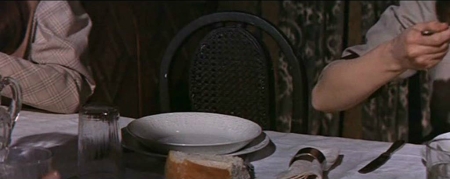
THE CRAWLING HAND, on balance, was always either going to be goofily bad or goofily good. The opening titles established two things — a certain imagination applied to a used-car budget, and a frankly staggering ignorance about basic film terminology. A group of long-in-the-tooth cameo celebrities are credited under “special thanks,” which is not something you usually say about people who are IN the film. The special effects department (ie probably an old guy in a potting shed) is listed as “cinematic effects,” which is charming but ambiguous.

The titles appear as we look past a spaceman’s head and shoulder and out through his plywood window frame at the vastness of interplanetary space, which is punctuated for some reason by a fireworks display. Which is weird, but I felt kind of good about it.
Next, we go to Space Control, which also seems to be mostly a lightweight wooden construction, and witness the astronaut suffer a rather traumatic fate — the bizarre makeup effects, simulating his zombie-like state, consist basically of a lot of eyeshadow, giving him a sinister new wave appearance, and then he blows up in a “cinematic effect” — the image rips into about six pieces which fly away out of view. Oddly, it’s quite upsetting. I’m reminded of my first glimpses of Linda Blair in THE EXORCIST, which my sister rented when I was too young to even WANT to see it. I thought the makeup was bad and over-the-top (makeup man Dick Smith was a truly great artist, but oddly his best known works, Blair here and Brando in THE GODFATHER, are not entirely successful, in my view), but I was still freaked out by it. This movie achieves the same thing (kudos to the actors for selling it) on about one-fifty-thousandth of the budget. The make-up, by being too obviously makeup, but being accepted by all the actors as a manifestation of something appalling, winds up being rather uncanny.

Next we meet a couple on the beach — a babyfaced James Dean wannabe (Rod Lauren) and flat-faced Swedish kitten (Sirry Steffen). We observe their teen antics for what seems like aeons (the movie’s biggest flaw — every scene goes on three times too long) until their discover a spaceman arm washed up by the tide. THE CRAWLING HAND is actually an entire crawling arm — more limb for your buck? Or is it just that since all the effort in this kind of special effect goes into hiding the rest of the actor (or props guy or director’s shiftless brother-in-law), having to hide less of him actually makes it easier?
Making it even easier is the fact that the arm exerts a malign influence, causing Baby-Dean to spontaneously emit eyeshadow of his own, and act out in a stroppy teen manner. The film’s subtext, an anxiety about the same young people it’s being marketed to, comes to the fore when he nearly kills his father-figure in a scene lit by a blaring jukebox.

Best guest star is Arline Judge, a beautiful and hilarious starlet of pre-code days, now typed as a frowsy landlady, toting a colossal handgun and unlit flashlight as she investigates strange noises. Suspicions allayed, she returns to bed — and a hand starts to crawl from under her pillow… look out, Arline Judge! Oh, it’s your own hand. Stand at ease. I suspect she may have thought of that idea herself — she was always a resourceful comic.
The movie has a relatively early example of the famed closeup-of-a-bee ending, in which it is implied that the crawling hand may still be out there, crawling. Although now a frightful cliché, this seemed like a smart thing for 1963, even if the reveal is played kind of jokey, so that it aims to unsettle (It’s still out there!”) and reassure (“We’re just kidding!”) at the same time. Still, it looked for a while like the titular extremity was going to end up eaten by kittens, which would be pretty ignominious. No sequel for you, crawling hand, unless it takes place in a litter tray.








